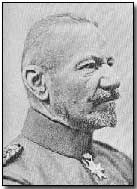Primary Documents - Max von Gallwitz on the Battle of St Mihiel, 12 September 1918
 First selected as a major
attack target by U.S. commanders in mid-1917, the German-held St. Mihiel
salient was ultimately assaulted by wholly independent U.S. forces on 12
September.
First selected as a major
attack target by U.S. commanders in mid-1917, the German-held St. Mihiel
salient was ultimately assaulted by wholly independent U.S. forces on 12
September.
Although considered an inadvisable and perhaps unnecessary target by U.S. Commander-in-Chief John J. Pershing's fellow Allied commanders - chiefly given the relative inexperience of his forces and the fact that fighting further north had taken precedence - the outcome proved Pershing triumphant. By 16 September the entire German salient had been effectively removed.
Reproduced below is a summary of the battle by local German commander General Max von Gallwitz.
Click here to read regional commander Crown Prince Wilhelm's assessment of U.S. troops immediately preceding the onset of the battle; click here to read an alternate account he subsequently detailed in his memoirs. Click here to read Pershing's official summary.
General Max von Gallwitz on the Battle of St Mihiel
Before the attack on the St. Mihiel triangle the American troops had been greatly strengthened. Their divisions had been welded together into army corps. By the beginning of September we learned of the formation of an independent Pershing American army, which was lying between the second and eighth French armies.
American divisions had fought honourably in the big battles which ended with the failure of our offensive at the Marne in July and August. It was an obvious suggestion to follow up this gradual development with some big feat, accomplished exclusively or largely by American troops under their own supreme command. An opportunity offered itself at St. Mihiel which had long been known.
Our position between the Meuse and the well-known height of Combre, southeast of Verdun, looked like an outstanding nose. It had taken this formation after the first battle in the Summer of 1914, and had been retained, fortified and honoured as the field of many single combats.
We had seven divisions that occupied this line, but they were reduced in number and among them were three of the militia and one Austrian division. The peril of this faulty triangle had always been patent to us. It lent itself to attack on all sides. We had repeatedly discussed the question of giving up this triangle. The chief in command agreed with me that no big battle in this territory was permissible.
But while we waited, the crisis came on apace. We never had time to carry off the materials we had gathered during an occupation of several years. On the other side lay the consideration that the yielding of a position held for years would be interpreted as a sign of weakness. Naturally we disregarded such considerations when the situation in other parts of the theatre of war was difficult.
There had been indications that something was brewing on the other side, but we were not certain as to which direction the attack might take. We were informed that the objective of the Americans was Metz and the territory east of that fortress, which would threaten our communication with the rear.
The centre of the enemy rear guard and communications was located on the southern side of the triangle, while on the northwest side everything was quiet, indicating that danger in the latter quarter was remote.
Then from foreign sources came the news that the American attack had been postponed - that the army was not yet ready for a big offensive movement.
We were surprised, therefore, when, on September 12, a concentrated attack was launched against the triangle. It was soon demonstrated that this was not a partial attack, but the execution of a great concentrated drive. The order to retire, which I gave on my own responsibility, but too late, could not prevent the loss of many troops and much material which had to be left behind.
The first deep advance took place on the southern side and was directed against two of our divisions, extending some twenty-three kilometres. Against the front covered by this attack nine or ten American divisions were led into battle, six being held in reserve.
The two divisions which I had in reserve behind the southern front could not succeed in turning the tide. The artillery and infantry collaborated better than ever, but there was little skill in profiting by the advance.
The American fliers made themselves very disagreeable. We learned that 800 of them were active at the front. Our units retired from the Mihiel position in order, although with losses. All of the retiring divisions, except one that was scattered (one which held Alsace-Lorraine men), were still employed in the front lines.
Although our retirement had been effected in good order, the enemy naturally considered it as forced.
I have experienced a good many things in the five years of war and have not been poor in successes, but I must count the 12th of September among my few black days.
Source: Source Records of the Great War, Vol. VI, ed. Charles F. Horne, National Alumni 1923
German losses at Messines were 25,000, of which 7,500 were taken prisoner. British casualties were 17,000 killed or wounded.
- Did you know?
